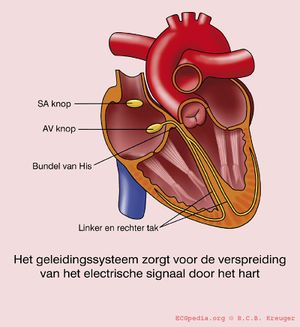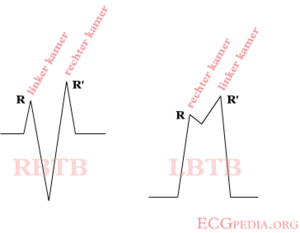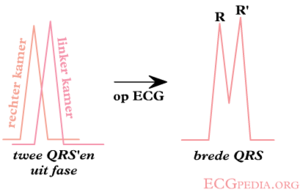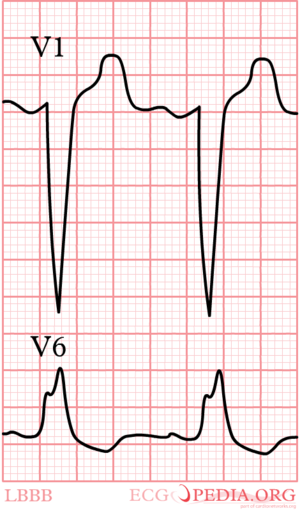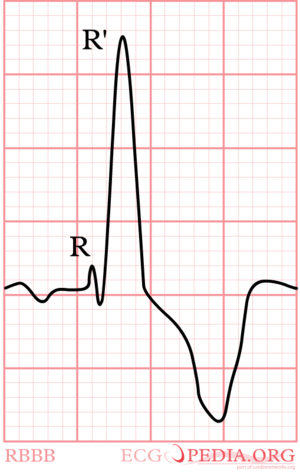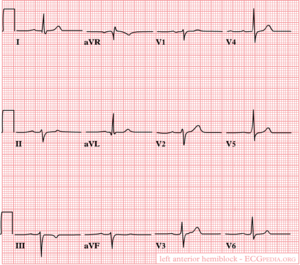Intraventricular Conduction: Difference between revisions
| Line 80: | Line 80: | ||
Phase 3 aberration occurs when conduction fibers receive a new impulse, before they have fully repolarized. This can sometimes be observed at the start of paroxysmal supraventricular tachycardias or in a long-short sequence where the refractory periode of the long sequence is prolonged. | Phase 3 aberration occurs when conduction fibers receive a new impulse, before they have fully repolarized. This can sometimes be observed at the start of paroxysmal supraventricular tachycardias or in a long-short sequence where the refractory periode of the long sequence is prolonged. | ||
===Retrograde Concealed Conduction=== | ===Retrograde Concealed Conduction=== | ||
Phase 3 aberration is often the cause of the first wide QRS complex. However at a regular rate retrograde concealed conduction is often the sustaining mechanism. The sequence of QRS widening that is often observed is phase 3 aberration in the first premature beat. This can leave the left bundle (as an example) refractory for the next beat. This next beat is conducted by the right bundle and once it reaches the apex, it is conducted retrograde by the left bundle. | Phase 3 aberration is often the cause of the first wide QRS complex. However at a regular rate retrograde concealed conduction is often the sustaining mechanism. The sequence of QRS widening that is often observed is phase 3 aberration in the first premature beat. This can leave the left bundle (as an example) refractory for the next beat. This next beat is conducted by the right bundle and once it reaches the apex, it is conducted retrograde by the left bundle. This can continue until a new premature ventricular beat causes a compensatory pause and 'resets' the system. | ||
===Phase 4 Aberration=== | |||
Phase 4 aberration only occurs after prolonged pause. During such a pause (e.g. in second degree AV block) the fibers of the Purkinje system can 'hyper'-depolarize spontaneously. As their membrane potential becomes more and more negative the conduction velocity reduces and they can even block altogether. This also requires an upwards shift of the threshold membrane potential and a change in membrane responsiveness, so it is rarely seen in normal hearts. | |||
===Phase 4 Aberration=== | ===Phase 4 Aberration=== | ||
Revision as of 05:32, 20 June 2007
| Author(s) | J.S.S.G. de Jong, MD | |
| Moderator | J.S.S.G. de Jong, MD | |
| Supervisor | ||
| some notes about authorship | ||
Conduction delay
If the QRS complex is wider than 0.12 seconds this is mostly caused by a delay in the conduction tissue of one of the bundle branches:
- Left Bundle Branch Block (LBBB))
- Right Bundle Branch Block(RBBB)
- Interventricular conduction delay
A right or left axis rotation can be caused by a:
Sometimes this conduction delay is frequency-dependent : the bundle branch block occurs only at higher heart rates and disappears at slower heart rates.
LBBB vs RBBB
Check V1 for QRS > 0,12 sec.
When the last QRS in V1 is below the baseline (moving away from V1), a LBBB is the most likely diagnosis.
When the last activity is above the baseline, it's a RBBB.
If the QRS > 0.12 sec. but the morphological criteria of LBBB or RBBB do not apply, it is called 'interventriculair conduction delay', a general term.
LBBB
- Criteria for left bundle branch block (LBBB) [1]
- QRS >0,12 sec
- Broad monomorphic R waves in I and V6 with no Q waves
- Broad monomorphic S waves in V1, may have a small r wave
In left bundle branch block (LBBB) the conduction in the left bundle is slow. This results in delayed depolarisation of the left ventricle, especially the left lateral wall. The electrical activity in the left lateral wall is unopposed by the usual right ventricular electrical activity. The last activity on the ECG thus goes to the left or away from V1. Once you remember this, LBBB is easy to understand.
RBBB
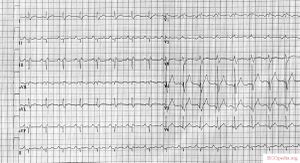
- Criteria for right bundle branch block (RBBB) [1]
- QRS >0,12 sec
- Slurred S wave in lead I and V6
- RSR'-pattern in V1 where R' > R
Again, watch V1. In right bundle branch block (RBBB) the conduction in the bundle to the right ventricle is slow. As the right ventricles depolarizes, the left ventricle is often halfway finished and few counteracting electrical activity is left. The last electrical activity is thus to the right, or towards lead V1. In RBBB the QRS complex in V1 is allways markedly positive.
LAFB
- Criteria for left anterior fascicular block
- left axis deviation (<-30°)
- no or very small S in lead I
- normal small q in lead I
- S > R in leads II and III
- no or very few QRS widening
In left anterior fascicular block the anterior part (fascicle) of the left bundle is slow. This results in delayed depolarisation of the upper anterior part of the left ventricle. On the ECG this results in left axis deviation. The QRS width is <0,12 seconds in isolated LAFB.
LPFB
- Criteria for posterior fascicular block
- right axis devation >+120°;
- deep S in I;
- small q in III;
- no or very few QRS widening;
- Right ventricular hypertrophy and previous lateral myocardial infarction have been excluded
Mechanisms of aberrant conduction
- Aberrant ventricular conduction is defined as
- QRS widening due to delay or block in bundle branch or intramyocardial conduction[2]
Aberrancy can result from:
- A sudden fastening of the heart rate that the bundles cannot conduct (phase 3 aberration)
- Retrograde concealed conduction
- A slow heart rate (phase 4 aberration)
Right bundle branch block is most common, because the right bundle has the longest refractory period. Left bundle branch block accounts for about 1/3rd of cases.
Phase 3 Aberration
Phase 3 aberration occurs when conduction fibers receive a new impulse, before they have fully repolarized. This can sometimes be observed at the start of paroxysmal supraventricular tachycardias or in a long-short sequence where the refractory periode of the long sequence is prolonged.
Retrograde Concealed Conduction
Phase 3 aberration is often the cause of the first wide QRS complex. However at a regular rate retrograde concealed conduction is often the sustaining mechanism. The sequence of QRS widening that is often observed is phase 3 aberration in the first premature beat. This can leave the left bundle (as an example) refractory for the next beat. This next beat is conducted by the right bundle and once it reaches the apex, it is conducted retrograde by the left bundle. This can continue until a new premature ventricular beat causes a compensatory pause and 'resets' the system.
Phase 4 Aberration
Phase 4 aberration only occurs after prolonged pause. During such a pause (e.g. in second degree AV block) the fibers of the Purkinje system can 'hyper'-depolarize spontaneously. As their membrane potential becomes more and more negative the conduction velocity reduces and they can even block altogether. This also requires an upwards shift of the threshold membrane potential and a change in membrane responsiveness, so it is rarely seen in normal hearts.
